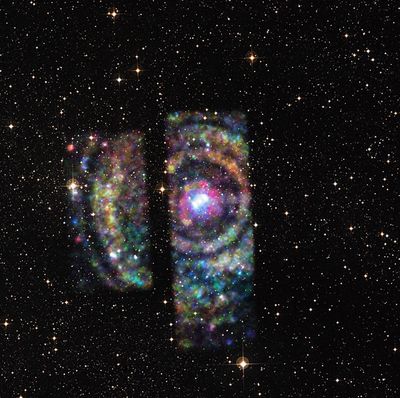‘Light echo’ helps researchers map parts of Milky Way

Thousands of years before humans invented agriculture, a bright burst of X-rays left the dense neutron star Circinus X-1, located in the faint Southern constellation Circinus. A year and a half ago, those X-rays were detected by the International Space Station, prompting a team of researchers led by University of Wisconsin, Madison’s Sebastian Heinz to investigate the source.
Today we know the light began its long journey 31,000 years ago.
Heinz led an international team of researchers to pinpoint the position of Circinus X-1 for the first time, finally telling astronomers just how powerful this system is. Using its “light echo” – X-rays bouncing off galactic dust and back to Earth – the astronomers were able to triangulate the location of the neutron star.
And by studying the dust between us and the star, the scientists are helping to map out the skeleton of our galaxy.
The light echo appears as rings of X-rays, radiating out from Circinus X-1 over time, much like the ripples seen after a stone is dropped in a pond.
“Distance in astronomy is really important,” Heinz said. “Unfortunately, it’s also one of the hardest things to really measure.”
An X-ray source like Circinus X-1 could be powerful and far away, or weaker and close to Earth. Measuring the distance answers that question, but dust and other obstacles between us and the star impair standard measuring tools. For Heinz, however, the dust proved crucial.
After Circinus X-1 flared up in late 2013, Heinz’s team used a telescope orbiting in space to search for light that was reflected by clouds of dust between us and the star, which reached Earth months later because of the extra distance traveled.
Although considered dense by space standards, each sheet of dust is insubstantial in Earthly terms.
“It is comparable to thin tissue paper for the clouds that generate the rings,” Heinz said. Yet these clouds are particularly good at reflecting X-rays.
Along with the angle and time delay of the reflected X-rays, the astronomers needed to know the distance to each dust cloud to triangulate Circinus X-1. By measuring the speed at which the dust swirls around the center of our galaxy, Heinz’s team could get this last piece of the puzzle and calculate back to the source.
The neutron star is 31,000 light-years from Earth, about halfway across the galaxy.
“It sheds a lot of light on what has been one of the more mysterious and prominent X-ray sources in the sky,” said Robert Benjamin, associate professor of astronomy at UW-Whitewater.
Benjamin consulted with Heinz at the beginning of this study and said he was impressed with the quality of the research that had developed since that time.
“If cleverly employed, there are probably at least a dozen more objects you could use this (technique) for,” said Frits Paerels, a professor of astronomy at Columbia University, who was not involved in this work. “This is a perfectly executed example.”
The scope of this research extends beyond the all-important distance. The clouds of dust that produced the light echo form the backbone of the Milky Way, and Heinz’s team imaged part of that dusty skeleton, providing just a little more information about our galactic home.